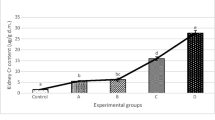Abstract
Chromium (Cr) potentiates the effects of insulin and a role for insulin in ascorbic acid transport has been reported. Therefore, the effects of Cr and ascorbate depletion on tissue ascorbic acid and14C distribution and excretion after a14C ascorbate dose were investigated in guinea pigs. As utilization of dietary Cr is affected by interaction with other minerals, tissue manganese (Mn), zinc (Zn), copper (Cu), and iron (Fe) were examined. For 20 wk, 40 weanling animals were fed either a Cr-deficient (<0.06 μg Cr/g diet, −Cr) or a Cr-adequate (2 μg Cr from CrCl3/g diet, +Cr) casein-based diet and were given 1 mg ascorbate/d (−C) or 10 mg ascorbate/d (+C) for 20 wk. Animals fed the Cr-depleted diet had decreased weight at 20 wk (p<0.01). Six hours before necropsy, animals were dosed by micropipette with 1.8 μCi ofl-[carboxyl-14C] ascorbic acid and placed in metabolic cages. Ascorbate supplementation increased Fe concentrations in most analyzed tissues, hepatic14C, tissue ascorbate and Mn concentration in the adrenal and testes, but decreased the concentrations of Cu in the kidney and Mn in the spleen. Liver Mn concentration was higher and kidney Mn concentration was lower in +Cr animals. Interactions between Cr and ascorbic acid affected Mn concentrations in bone and brain. These results indicate that ascorbate and Cr may affect Mn distribution. Chromium supplementation decreased plasma cortisol, brain14C and the amount of14C expired as carbon dioxide. These findings suggest that dietary Cr may affect ascorbic acid metabolism and the metabolic response to stress.
Similar content being viewed by others
References
G. V. Mann and P. Newton,Ann. NY Acad. Sci. 258, 243–252 (1975).
J. C. Kapeghian and A. J. Verlangieri,Life Sci. 34, 577–584 (1984).
E. J. Zebrowski, P. K. Bhatnager, and J. R. Brunka.J. Dental Res. 55, B145–147 (1976).
E. Ginter, B. Zdichynec, O. Holzerova, E. Ticha, R. Kobza, M. Koziakova, O. Cerna, L. Ozdin, F. Hruba, V. Novakova, E. Sasko, and M. Gaher,Int. J. Vit. Nutr. Res. 48, 368–373 (1978).
W. Mertz,Proceedings of the Seventh International Congress of Nutrition, Physiology and Biochemistry of Food Components, vol. 5, J. Kuhnau, ed., Permagon Press, London, pp. 689–692 (1967).
C. T. Gurson and G. Saner,Am. J. Clin. Nutr. 26, 988–991 (1973).
H. A. Schroeder,J. Nutr. 88, 439–445 (1966).
A. J. Speek, J. T. N. M. Thissen, and J. Schrijver,J. Clin. Chem. Clin. Biochem. 24, 465–470 (1986).
S. B. Heymsfield, C. Arteaga, C. McManus, J. Smith, and S. Moffitt,Am. J. Clin. Nutr. 37, 478–494 (1983).
H. Stolley, E. Zeh, and W. Droese,Eur. J. Pediatr. 125, 103–115 (1977).
C. J. Bates,Int. J. Vit. Nutr. Res. 49, 152–159 (1979).
M. J. Barnes, B. J. Constable, and E. Kodicek,Biochim. Biophys. Acta 184, 358–365 (1969).
K. I. Kivirikko and O. Laitinen,Acta Physiol. Scand. 64, 356–360 (1965).
V. A. Wilbur, and B. L. Walker,Nutr. Rep. Int. 16, 403–411 (1977).
C. J. Hahn and G. W. Evans,Am. J. Physiol. 228, 1020–1023 (1975).
L. L. Hopkins, Jr. and K. Schwarz,Biochim. Biophys. Acta 90, 484–491 (1964).
L. S. Hurley and C. L. Keen,Trace Elements in Human and Animal Nutrition, W. Mertz, ed., Academic Press, San Diego, CA, pp. 185–223 (1987).
G. J. Everson and R. E. Shrader,J. Nutr. 94, 89–94 (1968).
I. Bergman and R. Loxley,Clin. Chim. Acta 27, 347–349 (1970).
E. L. McGown, M. G. Rusnak, C. M. Lewis, and J. A. Tillotson,Anal. Biochem. 119, 55–61 (1982).
A. D. Hill, K. Y. Patterson, C. Veillon, and E. R. Morris,Anal. Chem. 58, 2340–2342. (1986).
J. J. Burns, P. G. Dayton, and S. Schulenberg,J. Biol. Chem. 218, 15–21 (1956).
W. Mertz,Physiol. Rev. 49, 163–239 (1969).
R. A. Anderson,Trace Elements in Human and Animal Nutrition, W. Mertz, ed., Academic Press, NY, pp. 225–244 (1987).
W. Mertz, E. E. Roginski, and K. Schwarz,J. Biol. Chem. 236, 318–322 (1961).
D. E. Kipp and J. M. Rivers,J. Nutr. 114, 1386–1395 (1984).
W. Mertz and E. E. Roginski,J. Nutr. 97, 531–536 (1969).
F. H. Nielsen,Nutr. Rev. 46, 337–341 (1988).
R. A. Anderson, M. M. Polansky, N. A. Bryden, E. E. Roginski, K. Y. Patterson, and D. C. Reamer,Diabetes 31, 212–216 (1982).
J. S. Borel and R. A. Anderson,Biochemistry of the Essential Ultratrace Elements, E. Frieden, ed., Plenum, NY, pp. 175–199 (1984).
J. R. Penney and S. S. Zilva,Biochem. J. 40, 695–706 (1946).
D. E. Kipp and J. M. Rivers,J. Nutr. 117, 1570–1575 (1987).
K. Nakano and S. Suzuki,J. Nutr. 114, 1602–1608 (1984).
R. E. Hughes, P. R. Jones, R. S. Williams, and P. F. Wright,Life Sci. 10, 661–668 (1971).
J. J. Burns, H. B. Burch, and C. G. King,J. Biol. Chem. 191, 501–514 (1951).
M. C. Nath, J. S. Dheer, N. Nath,Indian J. Exp. Biol. 6, 148–149 (1968).
D. B. Milne and S. T. Omaye,Int. J. Vit. Nutr. Res. 50, 301–308 (1980).
E. B. Finley and F. L. Cerklewski,Am. J. Clin. Nutr. 37, 553–556 (1983).
C. H. Smith and W. R. Bidlack,J. Nutr. 110, 1398–1408 (1980).
A. K. Majumder, B. K. Nandi, N. Subramanian, and I. B. Chatterjee,J. Nutr. 105, 240–244 (1975).
Author information
Authors and Affiliations
Rights and permissions
About this article
Cite this article
Seaborn, C.D., Cheng, N., Adeleye, B. et al. Chromium and chronic ascorbic acid depletion effects on tissue ascorbate, manganese, and14C retention from14C-ascorbate in guinea pigs. Biol Trace Elem Res 41, 279–294 (1994). https://doi.org/10.1007/BF02917429
Received:
Accepted:
Issue Date:
DOI: https://doi.org/10.1007/BF02917429



